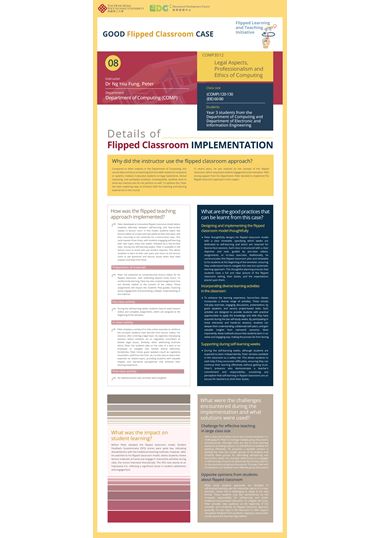
General Information
- Instructor: Dr Ng Hiu Fung Peter
- Department: Department of Computing
- Subject: COMP3512 Legal Aspects, Professionalism and Ethics of Computing
- Class size: (COMP) 120-130
(EIE) 60-80
- Students: Year 3 students from the Department of Computing and Department of Electronic and Information Engineering
Why Use the Flipped Classroom Approach?
Implementation Steps
Preparation of materials
Peter has prepared six comprehensive lecture videos for his flipped classroom, each extending beyond three hours. To reinforce the learning, Peter has also created assignments that are directly related to the content of the videos. These assignments will impact the students’ final grades, fostering active engagement and promoting a deeper understanding of the material.
Pre-class activity
During the self-learning weeks, students have to watch lecture videos and complete assignments, which are assigned at the beginning of the semester.
In-class activity
Peter employs a variety of in-class active exercises to reinforce the concepts students have learned from lecture videos. For instance, after covering a legal topic, he organises role-playing sessions where students act as Legislative Councillors to debate legal issues. Similarly, when addressing business ethics, Peter has students take on the roles of a boss or an employee to navigate and resolve ethical dilemmas. Sometimes, Peter invites guest speakers (such as Legislative Councillors, staff from the ICAC, etc.) to the class to share their expertise on related topics, providing students with valuable insights and real-world perspectives that enhance their learning experience.
Post-class activity
No additional post-class activities were assigned.
What Impact Did This Have on Student Learning?
What Are the Good Practices That Can Be Learnt from This Case?
Peter thoughtfully designs his flipped classroom model with a clear timetable, specifying which weeks are dedicated to self-learning and which are reserved for face-to-face sessions. Each class is structured with a clear objective and task, guided by pre-class videos, assignments, or in-class exercises. Additionally, he communicates this flipped classroom plan and timetable to his students at the beginning of the semester, ensuring they understand how to navigate this new but systematic learning approach. This thoughtful planning ensures that students have a full and clear picture of the flipped classroom setting, their duties, and the expectations placed upon them.
Incorporating diverse learning activities in the classroom
To enhance the learning experience, face-to-face classes incorporate a diverse range of activities. These include role-play exercises, engaging discussions, presentations by guest speakers, and various project-based tasks. Such activities are designed to provide students with practical opportunities to apply the knowledge and skills they have acquired during the two self-study weeks. By participating in these interactive and hands-on sessions, students can deepen their understanding, collaborate with peers, and gain valuable insights from real-world scenarios. Most importantly, these methods ensure that students learn in an active and engaging way, making the process far from boring.
Supporting during self-learning weeks
During the self-learning weeks, although students are expected to learn independently, Peter remains available in the classroom as a safety net. This allows students to seek help if they encounter difficulties, ensuring they can continue their learning effectively without getting stuck. Peter’s presence also demonstrates a teacher’s commitment and responsibility, countering any perception that self-learning or flipped classrooms are an excuse for teachers to shirk their duties.
What Were the Challenges Encountered During the Implementation and What Solutions Were Used?
With a class size of about one to two hundred students, it is challenging for Peter to manage multiple group discussions simultaneously. Although there are two to three teaching assistants providing support, it is still difficult to facilitate the teaching effectively. He proposes a possible solution is dividing the class into smaller groups of 40 students and schedule these groups for alternating self-learning and face-to-face weeks. For example, while Group A is engaged in self-learning, Group B can attend the face-to-face class for in-class exercises and group discussions. This way, Peter and his assistants can facilitate more effective group discussions.
Opposite opinions from students about flipped classroom
While some students appreciate the flexibility of self-directed learning and the interactive nature of in-class exercises, others find it challenging to adapt to the new format. These students may feel overwhelmed by the increased responsibility for self-learning and prefer traditional lecture-based instruction. To mitigate this issue, Peter provides clear guidance at the beginning of the semester and introduces his flipped classroom approach gradually. He also stays in the classroom to offer support and gather feedback from students, helping to reduce their anxiety about the new learning method.

